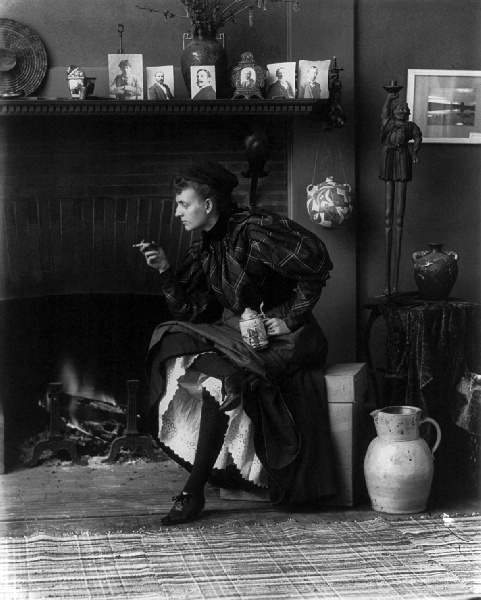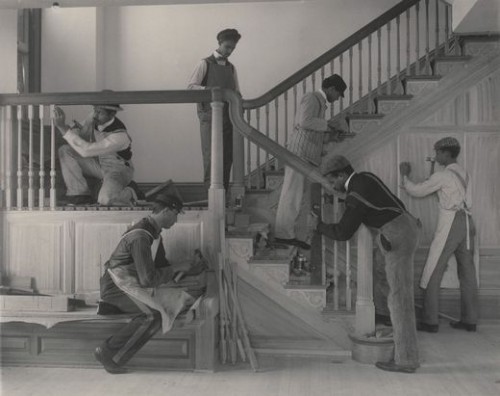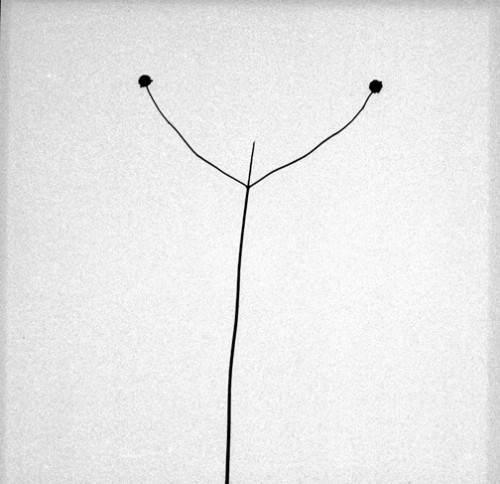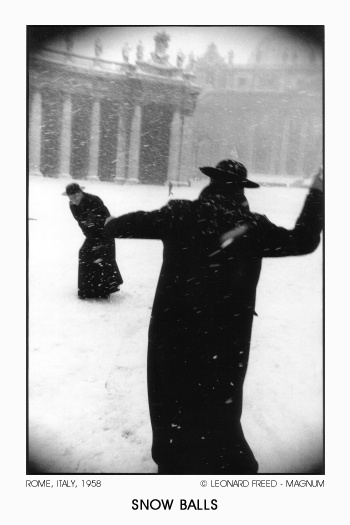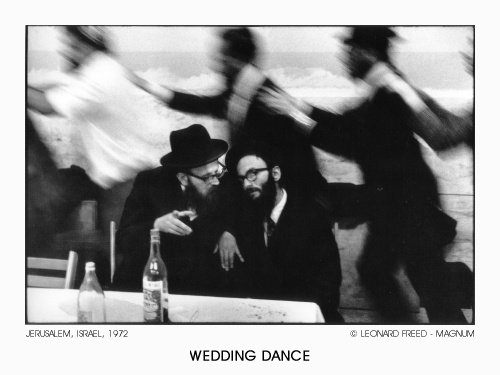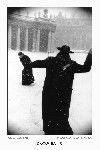Five Photography Exhibitions in Williamstown/North Adams
From 19th Century Views of Ruins to Photojournalism, Installations, and Digital Manipulation
By: Michael Miller - Jan 27, 2007
Five exhibitions in Williamstown and North Adams take the visitor far into varied regions of photography, its history and its current trends. A survey of the photojournalism of Leonard Freed, recently deceased, has been on view at the Brill Gallery at the Eclipse Mill in North Adams for several weeks already and will continue into the spring. Three more are on view at the Williams College Museum of Art: 1. "Drawing on Hopper: Gregory Crewdson/Edward Hopper" (October 12, 2006 –April 15, 2007); 2. "Carrie Mae Weems: The Hampton Project" (January 13, 2007–April 29, 2007); 3. "The Moon Is Broken: Photography from Poetry, Poetry from Photography" (November 11, 2006–July 8, 2007). Finally, the Clark just opened "In Search of Lost Time: Ruins in Photography" (January 9, 2007 - May 13, 2007) a small but representative exhibition of mid-nineteenth century photographs of antiquities in Rome, Egypt, Britain, and France. Any or all of the photographs on view might easily find their way into an historical survey without causing much discussion, but, as presented in the more specialized environments of these exhibitions, they become more engrossing and provocative.
As small as it is (thirteen photographs from the Clark's own collection and the Troob Family Foundation) "In Search of Lost Time" offers the visitor a meaningful glimpse of this important genre in early photography, thanks to the inclusion of four large prints by two of the major early specialists, the Englishman Francis Frith ( Derbyshire 1822 - Cannes 1898) and the Scot Robert Macpherson (Tayside 1811- Rome 1872). The remaining five prints are by the Englishmen Benjamin Brecknell Turner (1815-1894), James Anderson (1813-1877), whose firm, based in Rome, passed from father to son until the 1950s (The name is familiar to older generations of art historians, who remember shuffling through piles of them as exams approached.), and three Frenchmen, Félix Teynard (1817-1892), Charles Nègre (1820-1880), and Auguste Salzmann (1824-1872). In Teynard, Frith, Macpherson, and Anderson we see monuments of Egypt and Rome, while the others are represented by views of Arles, Whitby Abbey, and Jerusalem. Nobody can say that this is more than a smattering. Where is the pioneer Maxime du Camp, Flaubert's fellow-traveller in Egypt? Where is Greece?
Before he took up photography, Francis Frith had made a substantial fortune in wholesale groceries and printing. With this he financed his own expeditions to Egypt between 1856 and 1860, during which he made systematic photographs of the most renowned Egyptian monuments in the wet collodion process. In this he rivalled the work of his French predecessor Maxime du Camp, and eventually he built yet another business, Frith's of Reygate, which supplied travel pictures, views of far-off places, and postcards for the general market.
Robert Macpherson, who trained as a painter, also had a head for business. Early in life he settled in Rome, where he established himself as a landscape painter, art dealer, and photographer, calling himself an "artist-photographer." His firm grew to become a primary source for views of the city for foreign travellers. (As a dealer and connoisseur, he is also remembered as the discoverer of the striking "Entombment" in the National Gallery in London, occasionally thought to be the work of Michelangelo.) In these two photographers and in the clientele they served a pictorial genre developed which hovers between the two poles of photographic practise: documentation and art. The straightforwardness, even starkness, of their compositions grasps at an accuracy beyond the draftsman's reach, but it also follows the best artistic traditions of landscape, architectural study, and the documentation of antiquity. Macpherson's monumental view of the Colosseum is truly imposing and enabled the traveller to show his acquaintances exactly what he saw on his tour, but Macpherson's winter view of the waterfalls at Tivoli, already familiar to draftsmen and painters from Asselijn, Brill, and Dughet to Robert, Fragonard, Hackert, and Wilson, brings him into the company of the most distinguished vedutisti in pen and brush. In this astonishing image he captured both the volume of water pouring through ancient structure and the enormous wall of rock, but also the filigrees of the tree-branches against its spume.
The next stop on this photographic itinerary is the Williams College Art Museum, where three exhibitions are currently on view. I shall say little about "Drawing on Hopper," since it has already been reviewed in BFA by Jane Hudson, or about "The Hampton Project," because it has already been shown at the WCMA, which commissioned the work in 1999. The installation travelled and was amply discussed back then. However, it is interesting to observe how photography crosses over into other media, not only in these two shows, but also in "The Moon is Broken," the premise of which is the connection between photography and poetry. "Drawing on Hopper" presents two large images by Gregory Crewdson which draw their inspiration from the paintings of Edward Hopper. They share the gallery with Hopper's painting, "Morning in the City," together with a group of his preparatory drawings for it. This presentation leaves no doubt as to its nature as a painting, its concept developed in the classical manner through a series of sketches. Crewdson's complex studio lighting and the character of his prints bring his images somewhat out of the realm of photography, lending them a deceptive allure as pseudo-paintings. Photographs of Crewdson's Hollywood-sized studio filled with lights and props makes it clear that his exercise in hyper-realism is basically all a fake.
"The Hampton Project" is an installation by Carrie Mae Weems (curated by Vivian Patterson of the WCMA) based on a series of photographs by Frances Benjamin Johnston (1864-1952). The daughter of a prominent family, she studied painting at the Académie Julian in Paris, where she was steeped in academic traditions. After she abandoned painting for photography because of the truthfulness she saw in it, she developed a business as a commercial photographer. Through a combination of her ability and social connections she was sought after as a portraitist of presidents, socialites, and tycoons as well as a documentary photographer employed by well established institutions. She was commissioned to document the work of the Hampton Institute (a teaching and trade college for blacks founded by Williams graduate Samuel C. Armstrong) for display at the Paris Exposition in 1900.
Her work appears rather strange today. These documentary photographs are meticulously posed in the classical arrangements she studied in Paris; individual and multiple figures stand in such a way as to emphasize the flat, successive planes to which they are confined in space. What's more, Johnston printed them on platinum paper.* While this may strike us as an unduly refined way to present documentary photographs, it is enitrely characteristic of her age. The British photographer Peter Henry Emerson (1856-1936) strove for document, naturalism, and art in his work, and he made platinum prints, one of which appears to have hung in Johnston's studio, as her 1896 self-portrait shows. Her compositions, however, are self-consciously artificial in a way Emerson's was not, reflecting her own more classical aesthetic. If Emerson recalls Brueghel, Johnston evokes Masaccio, Ingres, and early Degas. (Is there irony in the Hampton Album? It has been discussed.) In the exhibition, they appear as a documentary adjunct to Carrie Mae Weems' gauzy banners, on which some of the images (and others) were printed through digital means, and texts, both printed on images and recorded. In "The Hampton Project" the installation artist of the late 1990's has transformed the photographic document of a century before into an environment of modern responses and reflections about history. While I found the installation absorbing, I couldn't not help thinking it was rather more dated than Fannie Johnston's original photographs.
Making my way through WCMA's modest medieval and renaissance gallery, where I was momentarily jarred by two of Kathleen Gilje's biting recreations of old paintings, I entered "The Moon is Broken," a exhibition seemingly dominated by the intense vision of the American photographers who were at the peak of their influence around the third quarter of the last century, among them Aaron Siskind, Harry Callahan, Garry Winogrand, and Ralph Gibson, although there were some prints by older and younger photographers. I had not knowingly come to pay homage to this aesthetic, and this is certainly not how the visitor is expected to enjoy the show. Individual prints are identified only in two spiral binders. The only wall texts beyond the introductory label are the names of the ten poets who made the final selection from a pool, which was pre-selected by the museum staff, as well as poems composed in response to the photographs. As stated in the introduction, "Together, they reviewed the museum's extensive photography collection and selected images that leave themselves open to poetic interpretation. In contrast to straight documentary photography that seeks to make declarative statements about events or pin down meaning, the selected images pose questions, evoke mystery, and create a puzzle for the eye. At turns abstract and ambiguous or descriptive and precise, these images endeavor to describe the essence of things in subtle and unexpected ways. Photographers featured in the exhibition range in style, intention, and time period, but all of their works share an evocation of the poetic."
I came to the exhibition as a participant in an Inkberry project for which we were supposed to write our own responses to the photographs. However, after looking over the first wall, selected by John Yau, noticing an old friend—Stieglitz' nocturnal view from a window of his Gallery 291—and reading the introductory label, I nervously seized one of the spiral binders to identify the photographers who weren't obvious. Knowing this was not my brief, I did this in the most cursory possible way, just enough to calm myself, and then I became immersed in the ten groupings of photographs. In the end I came away with the poetic impulse I was seeking, but also with a certain awe for the penetrating vision of the photographers represented in the gallery. (Significantly, the vast majority of the photographs were made between 1948 and 1972.) The statement that "these images endeavor to describe the essence of things in subtle and unexpected ways" seems like a rather tepid understatement in view of the power of these images. One doesn't develop this kind of revealing eye without pain, whether one is Winogrand in the desert, Gibson peering out a tenement window, Siskind letting his world tumble with a shadowy figure, or Kertesz clutching his breath at the shadow of a figure beyond a panel of textured glass. In these the objects photographed, no longer the subject of the photographs, are drained of mundane meaning and function. They are translated to another plane of being in a world of light and shade. To me this concentration of intense visions felt like a working-over from three massive thugs in the alley behind the museum. If photographic practice has changed and few photographers strive for this kind of pure imagery, I can't help thinking that something has passed from the medium. You can get your hands on a Leica and a thousand rolls of Tri-X, but it won't help. The world looked different to these people, even as recently as the 1960's.
There are other ways to see this multi-layered exhibition, however. On a subsequent visit, I was struck by the qualities of the individual groups and I thought about what each poet had seen in the images they chose. Some groups showed a single vision, others diversity, others told a story. For example, in Yau's group the desert scenes by Garry Winogrand and Robert Frank (They went out into the wilderness to find the place where natural and human wastelands meet.) contrasted with Stieglitz's private vision from the window of the office where he was confined many hours each day, as he ran his gallery. Rachel Barenblat saw moral worlds in textures and perpendicular and receding surfaces. Trudy Ames formed a compelling group around female body parts and their circumstances. Peter Filkins alone gave his exhibition a title: "Shadow Play." April Bernard led us from an ambiguous image of the upper part of a statue's face, wrapped in shadows and burlap, by the façade of a Chicago tenement, a Man Ray photogram with a light-bulb like shape, a butcher standing by a skinned calf's head, to one of Siskind's texture studies, dominated by a dark sweeping pattern. I'll leave the rest to you.
I've spoken to others who experienced the show primarily through the poetry with the photographs in a distant second place. There is in fact some striking verse on the walls, showing, more than the photographs, vastly different techniques and mentalities.
Apart from the admirable quality of the photographic collection at the WCMA, there are many lessons to be learned in "The Moon is Broken," but above all I believe it was salutary to be immersed in one of the strongest aspects of twentieth century photography, and I'd recommend the show most urgently—above all to photographers. I haven't finished with it yet, either.
The next and final leg of this photographic expedition calls for a fifteen-minute drive to the Eclipse Mill in North Adams, or perhaps you should take that imaginary Leica with you on the blue bus, or walk, as a friend of mine often does. Ralph Brill of the Brill Gallery has assembled over forty prints of photographs by Leonard Freed, the Magnum photojournalist, who died this past November after a rich life based in Amsterdam, but reaching into many corners of the globe.
I'll continue the theme of "The Moon is Broken" with a quotation of Freed's which heads the exhibition: "For me, photography has a lot to do with curiosity and wonderment. It's getting excited about the little things, like a blade of grass in the woods or the movement of an arm through space. It is of being visual. Of seeing connections between objects and concepts. Of telling a story in visual terms, an example being legs crossed or uncrossed. It's of being a child in a child's world while wandering through it as the adult that we are." Leonard Freed carried this innocent vision along to Hassidic weddings, police stations and murder scenes in New York, war-stricken Jerusalem, pre-civil rights ghettos in the South, Germany at the height of the Wirtschaftswunder, Wall Street, and a snow-covered Saint Peter's Square, to name only a few.
Some of Freed's images will strike you as familiar, if perhaps you may not be able to remember so easily where you saw them. A half-generation younger (b. Brooklyn 1929) than some of the classic photojournalists like Robert Capa and Henri Cartier-Bresson, he settled in Amsterdam in 1958 and joined Magnum in 1972, after concentrated projects like his photography of blacks in America (1964-65), the Israeli war of 1967 and the Yom Kippur War (1973), and the New York Police Department (1972-1979). While amply represented in major news magazines, (for example "Life," "Paris Match," "Der Spiegel," "Sunday Times Magazine," "New York Times Magazine," and "L'Express") and his coverage of the American civil rights movement made him famous, he tended to follow his own direction, making his most significant statements in books, for example, Black in White America (1967), Made in Germany (1970), Police Work (1980), and The Dance of the Faithful (1984), a collection of many years of photographs of Jewish life around the world.
All of these projects and more are amply represented at the Brill Gallery, especially his photographs of blacks, Jewish subjects, and the New York Police, along with a selection of miscellaneous observations, including his famous 1956 shot of Wall Street, which Cartier-Bresson greatly admired. Standing below street on the subway stairs, Freed captured three primary figures in contrasting attitudes. A summer-suited man in a straw pork-pie hat purposefully crosses the field, while an unprepossessing tieless man swings down into the stairway and in the foreground a corpulent middle-aged man descends, dreamily smoking. In Freed's work these human interactions can be closer and more intense, either playfully, as in the scene of two seminarians engaging in a snowball fight in front of St. Peter's (1958), or brutally, as in "Prisoner's Tattoos," (1972) in which bare-armed men crowd together in a New York City jail. There is also isolation, as in the corpse stretched out at the bottom of tenement stairs in "Death by Overdose" (1972) or the ragged but smiling figure in "Moroccan Jew" (1962).
The show offers another opportunity not to be missed, to compare his visceral photographs of blacks in the South of the mid-1960's with Johnston's sanitized documentation of life and learing at the Hampton Institute. Again, one of the most haunting pictures in this group was taken in a prison.
Leonard Freed had a quick and sympathetic eye, not only for the extremes of human misery and, if not joy, at least fun and pleasure, as well as fleeting moments of everyday life when individual character and its condition in the world seem to explode in our faces. Freed was above all a humanist of deep sensibility, who saw his work as poetry. In contrast to the reductive photographers of "The Moon is Broken" his eye saw meaning in human events. He was also an eloquent writer, and I'll quote him once more: "This...is a journey through one photographer's mind. It is photojournalism, a collection of photographs telling a story; a novel, one of many written by the author. Written and rewritten. The subject: life with all its emotions, a mosaic in the round; the never ending seduction that continues from generation to generation. Photography is a visual language still in its infancy. Just as the poet adds meaning to words, so the photographer adds to visual symbols. But, whereas the other arts developed in time over centuries, photography has yet to mature and define itself. The fact that millions of people can see the same visual images on television, in films or photography is communication. It is a language. To be a poet-photographer is both saddening and challenging. Saddening to think that literary traditions are being lost to a language that is only in its infancy. Challenging in that one is free to be original."
As a practical footnote, I should add that the works on view at the Brill Gallery are for sale, in vivid prints made by Steinmetz in Paris for Freed, who lost interest in printing his own work early on. Some are available in affordable Iris prints.
---
*The installation at the WCMA does not show the originals, which are in the collection of the Museum of Modern Art in New York, but photographic copies on modern platinum paper by the Chicago Albumen Works. These a noticeably coarser than the originals and lack the subtle glow of a period platinum print. It is intriguing to note that Johnston's Hampton Album was discovered in a Washington bookshop in 1944 by Lincoln Kirstein, later the founder of the New York City Ballet, who presented it to MoMA, presumably through his friend Alfred Barr. At the end of the war he continued this serendipitous art-searching as one of the principle "monuments men," entrusted with the recovery of artworks looted by the Nazis. He figures prominently in Robert M. Edsel's book, "Rescuing Da Vinci," the subject of a recent review in BFA.



